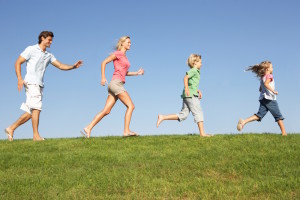
10,000 steps. A step is approximately one-third to one-half an adult or child’s height. For example, a person six feet tall would cover 20,000 to 30,000 feet or approximately 4 to 5 miles with 10,000 steps. In contrast, a child three-feet tall would cover two to three miles with 10,000 steps.
The idea of 10,000 steps began as a marketing slogan in the 1960’s for cardio-vascular fitness using a pedometer. 10,000 steps is a catchy phrase to help us remember that we need a minimum amount of daily activity in order to maintain a basic level of health.
Recent research shows that children ages six to twelve probably need 12,000 to 15,000 steps per day to maintain fitness and avoid weight gain.
This translates to the equivalent of two to two-and-a-half hours of walking per day. Those of us who exercise less than 5,000 steps per day are at risk for diabetes and obesity.
In an article in Parents Magazine, Dr. Sanghavi, a pediatric heart doctor, discussed his findings after using a pedometer to measure his four-year-old son’s activity level. Dr. Sanghavi discovered that his son logged over 30,000 steps, or an impressive nine miles, in a single day at an amusement park. Back home in his normal routine, his son took a little over 5,000 steps per day, or a half to a third of the activity necessary for a basic level of fitness.
Walking, running, bicycling and swimming promote important aspects of cardio-vascular, aerobic, mental and brain development.
As oxygen levels increase through activity, the work of the body and the mind becomes more efficient and effective.
Our children’s activity level affects not just their physical health but also their brain development. Exercises that incorporate bilateral movements, where the left arm moves with the right leg and the right arm moves with the left leg, aid in the development of the neuron connections in the corpus callosum between the hemispheres of the brain. These connections in the corpus callosum are created more easily in the child before the age of six. Movement and brain development are intricately interwoven for all of our lives.
The right hemisphere of the brain controls visual and spatial function as well as emotion and musical abilities. The right brain is often referred to as the creative side of the brain. The left hemisphere is involved with the use of logic, language and reasoning. The corpus callosum acts as the communication device between the hemispheres, in essence, allowing us to use our whole brain. 10,000 steps (read also as basic activity level) help the brain and body to interconnect.
By lengthening the school day and reducing recess times, in our quest to increase our children’s tests scores, we are giving our children fewer opportunities to build and maintain a basic fitness level. Electronic devices at home vie for our children’s attention and reduce the time that could be used to take 10,000 steps.
We need to realize that physical activity is more than time taken away from other learning.
Physical activity aids learning. A minimum level of activity is critical to our children’s long-term health and development, both physically and mentally.
Let’s remember that the journey of a thousand miles begins with the first step. A lifetime of health begins with 10,000 steps.

